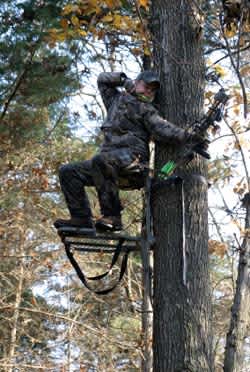Tree Stand Safety: Protecting Yourself from Yourself
Northeast Hunting 09.02.11

Ever consider who or what represents the greatest danger to you in the field? Other hunters? Weather? Weapon malfunction? Actually, look no further than the mirror.
Statistically speaking, the guy looking back at you can be the most likely to do you harm while hunting. Tree stand injuries have been on the rise in recent years and sadly, most are preventable.
Wayne East, executive director of the International Hunter Education Association stated, “It is estimated that more hunters are injured from tree stand related injuries than all other hunting incidents combined.
Taking into account that there is no legal requirement to report tree stand injuries and the vast majority of incidents go unreported. After all, who wants to go on record as having failed to observe basic safety protocol, and injured themselves in the process?”
Such trends are difficult to ignore and hunters have to face the fact that hunting from trees is inherently dangerous. Climbing in and out with weapons and associated gear is a cumbersome task, especially in the low/no light conditions at each end of the hunt.
Consider that your favorite perch could be a lofty 12-18 feet above ground, and the list of potential perils isn’t hard to imagine. Broken bones and torn ligaments await the more fortunate, while broadhead impalement, gunshot wounds, even self lynching are on the menu for the tragically ill fated.
With such high stakes it’s hard to imagine why anyone would roll the dice, especially when a little common sense and discipline can go a long way toward keeping you in your tree and out of the emergency room. It is essential to develop a system for the safe set up, mounting and dismounting of your stand, as well as establishing limits for what you do once you are in place.
Below are guidelines posted by the TMA (Tree stand Manufacturer’s Association) for the safe use of tree stands. The beginner will find it to be an excellent primer, and it is also a great refresher for the experienced tree dweller. Stay safe, shoot straight, and keep that taxidermist on speed dial!
Tree stand Safety Guidelines
- ALWAYS wear a Fall-Arrest System (FAS)/Full Body Harness meeting TMA Standards even during ascent and descent. Be aware that single strap belts and chest harnesses are no longer allowed Fall- Arrest devices and should not be used. Failure to use a FAS could result in serious injury or death.
- ALWAYS read and understand the manufacturer’s WARNINGS & INSTRUCTIONS before using the tree stand each season. Practice with the tree stand at ground level prior to using at elevated positions. Maintain the WARNINGS & INSTRUCTIONS for later review as needed, for instructions on usage to anyone borrowing your stand, or to pass on when selling the tree stand. Use all safety devices provided with your tree stand.
- ALWAYS inspect the tree stand and the Fall-Arrest System for signs of wear or damage before each use. Contact the manufacturer for replacement parts. Destroy all products that cannot be repaired by the manufacturer and/or exceed recommended expiration date, or if the manufacturer no longer exists. The FAS should be discarded and replaced after a fall has occurred.
- ALWAYS attach your Full Body Harness in the manner and method described by the manufacturer. Failure to do so may result in suspension without the ability to recover into your tree stand. Be aware of the hazards associated with Full Body Harnesses and the fact that prolonged suspension in a harness may be fatal. Have in place a plan for rescue, including the use of cell phones or signal devices that may be easily reached and used while suspended. If rescue personnel cannot be notified, you must have a plan for recover/escape. If you have to hang suspended for a period of time before help arrives, exercise your legs by pushing against the tree or doing any other form of continuous motion or use your suspension relief device. Failure to recover in a timely manner could result in serious injury or death. If you do not have the ability to recover/escape, hunt from the ground.
- ALWAYS hunt with a plan and if possible a buddy. Before you leave home, let others know your exact hunting location, when you plan to return and who is with you.
- ALWAYS select the proper tree for use with your tree stand. Select a live straight tree that fits within the size limits recommended in your tree stand’s instructions. Do not climb or place a tree stand against a leaning tree. Never leave a tree stand installed for more than two weeks since damage could result from changing weather conditions and/or from other factors not obvious with a visual inspection.
- ALWAYS use a haul line to pull up your gear and unloaded firearm or bow to your tree stand once you have reached your desired hunting height. Never climb with anything in your hands or on your back. Prior to descending, lower your equipment on the opposite side of the tree.
- NEVER hurry! While climbing with a tree stand, make slow, even movements of no more than ten to twelve inches at a time. Make sure you have proper contact with the tree and/or tree stand every time you move. On ladder-type tree stands, maintain three points of contact with each step.

